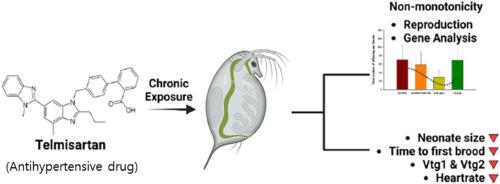当前位置:
X-MOL 学术
›
Environ. Pollut.
›
论文详情
Our official English website, www.x-mol.net, welcomes your
feedback! (Note: you will need to create a separate account there.)
Reproductive toxicity and molecular responses induced by telmisartan in Daphnia magna at environmentally relevant concentrations
Environmental Pollution ( IF 7.6 ) Pub Date : 2024-07-14 , DOI: 10.1016/j.envpol.2024.124525 Kimberly Etombi Muambo 1 , Hyungjoon Im 2 , Fulgence Jacob Macha 3 , Jeong-Eun Oh 4
Environmental Pollution ( IF 7.6 ) Pub Date : 2024-07-14 , DOI: 10.1016/j.envpol.2024.124525 Kimberly Etombi Muambo 1 , Hyungjoon Im 2 , Fulgence Jacob Macha 3 , Jeong-Eun Oh 4
Affiliation

|
With aging population increasing globally, the use of pharmaceutically active compounds is rising. The cardiovascular drug telmisartan has been widely detected in various environmental compartments, including biota, surface waters, and sewage treatment plant effluents at concentrations ranging from ng/L to μg/L levels. This study evaluated the effects of telmisartan on the microcrustacean at a wide range of concentrations (0.35, 0.70, 1.40, 500, and 1000 μg/L) and revealed significant ecotoxicological implications of this drug, even at environmentally relevant concentration. Acute exposure to telmisartan (1.40, 500, and 1000 μg/L) resulted in a notable decrease in heart rate, while chronic exposure accelerated the time to the first brood by 3 days and reduced neonate body size. Molecular investigations revealed marked downregulation of vitellogenin genes ( and ). Non-monotonic dose responses were observed for gene expression, early-stage body length, and the total number of offspring produced, while the heart rate and time to the first brood showed clear concentration-dependent responses. These findings highlight the potential risks, notably to reproductive capacity, associated with exposure to telmisartan in environmentally relevant concentration, suggesting the need for further studies on the potential long-term ecological consequences.
中文翻译:

环境相关浓度下替米沙坦在大型溞中诱导的生殖毒性和分子反应
随着全球人口老龄化的加剧,药物活性化合物的使用正在增加。心血管药物替米沙坦已在各种环境区域中广泛检测到,包括生物群、地表水和污水处理厂废水,其浓度范围为 ng/L 至 μg/L 水平。这项研究评估了替米沙坦在多种浓度(0.35、0.70、1.40、500 和 1000 μg/L)下对微甲壳类动物的影响,并揭示了该药物的显着生态毒理学影响,即使在环境相关浓度下也是如此。急性暴露于替米沙坦(1.40、500 和 1000 μg/L)会导致心率显着下降,而慢性暴露则使初孵时间加快 3 天,并减小新生儿体型。分子研究显示卵黄蛋白原基因显着下调(和)。在基因表达、早期体长和产生的后代总数方面观察到非单调剂量反应,而心率和第一窝时间显示出明显的浓度依赖性反应。这些发现强调了与环境相关浓度的替米沙坦暴露相关的潜在风险,特别是对生殖能力的风险,表明需要进一步研究潜在的长期生态后果。
更新日期:2024-07-14
中文翻译:

环境相关浓度下替米沙坦在大型溞中诱导的生殖毒性和分子反应
随着全球人口老龄化的加剧,药物活性化合物的使用正在增加。心血管药物替米沙坦已在各种环境区域中广泛检测到,包括生物群、地表水和污水处理厂废水,其浓度范围为 ng/L 至 μg/L 水平。这项研究评估了替米沙坦在多种浓度(0.35、0.70、1.40、500 和 1000 μg/L)下对微甲壳类动物的影响,并揭示了该药物的显着生态毒理学影响,即使在环境相关浓度下也是如此。急性暴露于替米沙坦(1.40、500 和 1000 μg/L)会导致心率显着下降,而慢性暴露则使初孵时间加快 3 天,并减小新生儿体型。分子研究显示卵黄蛋白原基因显着下调(和)。在基因表达、早期体长和产生的后代总数方面观察到非单调剂量反应,而心率和第一窝时间显示出明显的浓度依赖性反应。这些发现强调了与环境相关浓度的替米沙坦暴露相关的潜在风险,特别是对生殖能力的风险,表明需要进一步研究潜在的长期生态后果。


















































 京公网安备 11010802027423号
京公网安备 11010802027423号